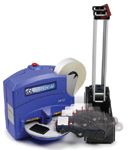Digital Update
Online SPE capability for CTC platforms; UV-Visible Spectrophotometer Web Tool; Automatic Microplate Sealing and Stacking System; Cheminformatics Software
Online SPE capability for CTC platforms
The MEPS Online kit provides hardware, software and support to provide online SPE capability to a CTC platform using the MEPS SPE system.
Users can access SPE online quickly — including macros, object manager and holders for easy installation and setup — according to the manufacturers. The kit contains over 60 applications for pharmaceutical, DAU and environmental applications.

The MEPS Online kit is the product of collaboration between SGE Analytical Science who developed the MEPS product, CTC Analytics who provided the platform for automation of the MEPS concept, and SciSEP who develop and support the MEPS application on the CTC platform.
The MEPS Online kit can be ordered through SciSep (UK only), or any authorized CTC distributor (all countries except UK).
UV-Visible Spectrophotometer Web Tool
Thermo Fisher Scientific has updated its interactive web-based tool aimed at scientists who use ultraviolet/visible (UV/vis) detectors.

The web selector guide, available at www.thermo.com/selectuv, allows current and prospective scientists in the life science, pharmaceutical, material science and general laboratory markets to select an appropriate UV/vis spectrophotometer for their laboratory requirements.
The redesigned web tool now features the Evolution 60; a low-cost, 1.0 bandwidth instrument designed for performance with a very compact footprint. Additionally, the NanoDrop 1000 and NanoDrop 8000 spectrophotometers are also incorporated, providing assistance for customers interested in microvolume sampling for life science applications.
The web tool navigates users through a logical progression of application questions and answers, including specific sections for material science and life science applications. Users can compare features from a comprehensive range of product information to help customers select the most appropriate system for their laboratory.
For customers with specific application and technical questions, a straightforward contact form is provided. In addition, the tool provides assistance for first-time users of UV/vis spectrophotometers, guiding them through a detailed glossary that explains technical concepts in simple detail.
Automatic Microplate Sealing and Stacking System
Porvair Sciences has produced a new online video that demonstrates how its TriSeal High Throughput Sealing Station provides busy laboratories with a compact, solution for automated microplate sealing and stacking.

The wmv format streaming video demonstrates how, with one command, the station can be instructed to securely seal and store up to 100 microplates. Featuring the Scorpion stacker/loader, the video shows how the instrument uses a single Scorpion to load and unload the TriSeal. As the first plate is sealed inside, a second plate is automatically added to the turntable before the ejected sealed plate is removed and returned to the 'sealed' stack. A single interface box is used to control the stacker/loader and the station.
Combining the flexibility of a three-position turntable with the convenience of unattended microplate loading and unloading the station offers significant productivity and throughput benefits to the busy screening or compound management laboratory.
The station can produce an accurate and tight seal on any SBS proposed standard microplate from 5–47 mm in height. Offering adjustable temperature heat sealing from 50–185 °C the station can operate optimally with most foil & film seals, according to the manufacturers.
Cheminformatics Software
Isentris 3.1 from Symyx Technologies allows scientists to create, manage, and share fully searchable local databases and to work offline. Symyx claims this functionality goes well beyond its ISIS software, and provides an ideal transition point for ISIS-to-Isentris migration.

New Isentris functionality includes the creation, management and sharing of fully searchable local databases with full insert, update, and delete capabilities. This can improve R&D productivity by enabling researchers to capture, annotate, and explore data in a familiar environment, according to the manufacturers.
Researchers can also travel with their data or share project-critical information with external collaborators such as contract research organisations (CROs). Local databases support business-critical workflows in the exchange and communication of scientific information between scientists and project groups.
Isentris provides highly interactive views of scientific information in a self-service environment. Scientists can filter, sort and cluster data themselves to see exactly what they need to make decisions.
The facility for molecule and reaction clustering enables scientists to make better decisions by quickly and efficiently grouping search results. Isentris 3.1 offers chemical structure searching in Microsoft Excel spreadsheets which speeds up hypothesis testing by searching and filtering chemical structures, according to the manufacturers, New support facilities for polymers, mixtures, and formulations allows scientists to capture, store, and search the company's intellectual property in areas including biologics, chemicals and consumer goods.
University of Oklahoma and UC Davis Researchers Probe Lipidomic Profiles with RP-LC–HRMS/MS
May 6th 2025A joint study between the University of Oklahoma Health Sciences Center (Oklahoma City, Oklahoma) and the UC Davis West Coast Metabolomics Center (Davis, California) identified differentially regulated lipids in type 2 diabetes (T2D) and obesity through the application of reversed-phase liquid chromatography-accurate mass tandem mass spectrometry (RP-LC-accurate MS/MS).
Altering Capillary Gas Chromatography Systems Using Silicon Pneumatic Microvalves
May 5th 2025Many multi-column gas chromatography systems use two-position multi-port switching valves, which can suffer from delays in valve switching. Shimadzu researchers aimed to create a new sampling and switching module for these systems.
Studying Cyclodextrins with UHPLC-MS/MS
May 5th 2025Saba Aslani from the University of Texas at Arlington spoke to LCGC International about a collaborative project with Northwestern University, the University of Hong Kong, and BioTools, Inc., investigating mirror-image cyclodextrins using ultra-high performance liquid chromatography–tandem mass spectrometry (UHPLC–MS/MS) and vibrational circular dichroism (VCD).

.png&w=3840&q=75)

.png&w=3840&q=75)



.png&w=3840&q=75)



.png&w=3840&q=75)











